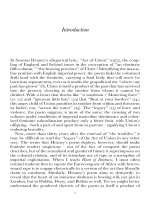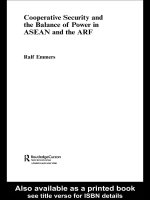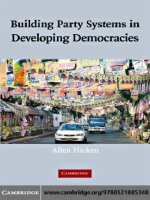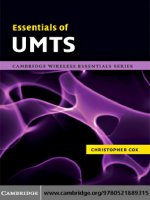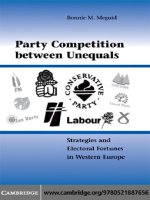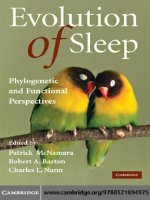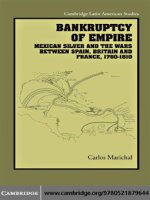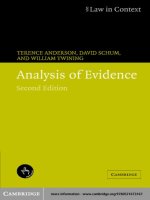Cambridge.University.Press.Allegories.of.Union.in.Irish.and.English.Writing.1790-1870.Politics.History.and.the.Family.from.Edgeworth.to.Arnold.Oct.2000.pdf
Bạn đang xem bản rút gọn của tài liệu. Xem và tải ngay bản đầy đủ của tài liệu tại đây (984.53 KB, 240 trang )
aaaaaa
This page intentionally left blank
ALLEGORIES OF UNION
IN IRISH AND
ENGLISH WRITING,
–
In this book, Mary Jean Corbett explores fictional and non-
fictional representations of Ireland’s relationship with England
throughout the nineteenth century. Through postcolonial and
feminist theory, she considers how cross-cultural contact is negoti-
ated using tropes of marriage and family, and demonstrates how
familial rhetoric sometimes works to sustain, sometimes to contest,
the structures of colonial inequality. Analyzing novels by
Edgeworth, Owenson, Gaskell, Kingsley, and Trollope as well as
writings by Burke, Carlyle, Engels, Arnold, and Mill, Corbett
argues that the colonizing imperative for ‘‘reforming’’ the Irish in
an age of imperial expansion constitutes a largely unrecognized but
crucial element in the rhetorical project of English nation-forma-
tion. By situating her readings within the varying historical and
ideological contexts that shape them, she revises the critical ortho-
doxies surrounding colonial discourse that currently prevail in Irish
and English studies, and offers a fresh perspective on important
aspects of Victorian culture.
is Associate Professor of English and
Affiliate of Women’s Studies at Miami University in Oxford, Ohio.
Her publications include Representing Femininity: Middle-Class Subjec-
tivity in Victorian and Edwardian Women’s Autobiographies (). Her
work has also appeared in Criticism, Eighteenth-Century Life, ELH,
Studies in the Novel, and Women’s Studies.
aaaaaa
ALLEGORIES OF UNION
IN IRISH AND
ENGLISH WRITING,
–
Politics, History, and the Family from Edgeworth to Arnold
MARY JEAN CORBETT
The Pitt Building, Trumpington Street, Cambridge, United Kingdom
The Edinburgh Building, Cambridge CB2 2RU, UK
40 West 20th Street, New York, NY 10011-4211, USA
477 Williamstown Road, Port Melbourne, VIC 3207, Australia
Ruiz de Alarcón 13, 28014 Madrid, Spain
Dock House, The Waterfront, Cape Town 8001, South Africa
First published in printed format
ISBN 0-521-66132-3 hardback
ISBN 0-511-03346-X eBook
Mary Jean Corbett 2004
2000
(Adobe Reader)
©
My family on both sides belonged to the toiling and dying types
who made it over to America.
And once in America, people divided once again: you could say
they became the poor and the rich. The losers and winners. The
artists and scientists. If they were countries, they’d be Ireland and
England.
Carolyn See, Dreaming: Good Luck and Hard Times in America
Of the numbers who study, or at least who read history, how few
derive any advantage from their labours!
Maria Edgeworth, Preface to Castle Rackrent
MMMM
Contents
Acknowledgmentspageix
Introduction
Public affections and familial politics: Burke, Edgeworth,
andIrelandinthes
Allegories of prescription: engendering Union in
OwensonandEdgeworth
Troubling others: representing the immigrant Irish in
urbanEnglandaroundmid-century
Plottingcolonialauthority:Trollope’sIreland,–
England’s opportunity, England’s character: Arnold, Mill,
andtheUnioninthes
Afterword
Notes
Bibliography
Index
vii
aaaaa
Acknowledgments
A book that has taken this long to write has run up exorbitant debts in its
author’s name. First and foremost, I owe my mother, Joan; my brothers,
Dennis, Bill, and Tom; my sisters, Susan and Judy; and the bright lights
of the next generation – Lauren, Brendan, Conor, Mara, Liam, and
Brigit – for putting up with it, and with me. Always and everywhere,
Regenia Gagnier and Rob Polhemus remain what I hope to become;
much love and thanks to both for their extravagant kindness and
unstinting support. Shay Brawn, Alex Chasin, Ira Livingston, and Kelly
Mays are still among the best friends I’ve ever made, and I feel beyond
fortunate to have all of them in my life, more than ten years on. And
there will be no end to owing Brad King, Maggy Lindgren, Lucy
Jackson Norvell, Nedra Reynolds, Kate Rousmaniere, and Ann Wier-
wille for their care, friendship, and encouragement.
I need to repay with interest those colleagues in English at Miami
University who have contributed to the process and the product in
either highly concrete or virtually intangible ways, often in both: Steven
Bauer, Kim Dillon, Eric Goodman, Susan Jarratt, Katie Johnson, Frank
Jordan, Laura Mandell, Kate McCullough, Lori Merish, Kerry Powell,
and Vicki Smith, with special thanks to Tim Melley for providing a
timely reading and to Barry Chabot for giving us all a local habitation.
I’m obliged as well to the innumerable graduate and undergraduate
students I’ve known and admired in the past ten years, who have given
me way more than they realize, and to all manner of other folks with
whom I’ve talked and to whom I’ve listened, especially Deborah Morse
and Anca Vlasopolos, along with many other members of the Interdisci-
plinary Nineteenth Century Studies Association. Two other colleagues
have also enriched my work in particularly important ways, which they
would fully recognize only in reading the pages of this book: my deepest
gratitude for their intellectual companionship to Fran Dolan and to
Susan Morgan.
ix
For the gifts of time and institutional support, I thank the Committee
on Faculty Research, the Department of English, and the College of
Arts and Sciences at Miami University. I’m also obliged to Ray Ryan of
Cambridge University Press, and to the two anonymous readers of the
manuscript, who have improved it by their knowledge and rigor. An
earlier version of the argument on Owenson in Chapter Two appeared
as ‘‘Allegories of Prescription: Engendering Union in The Wild Irish
Girl,’’ Eighteenth-Century Life (). And some of the material on Burke
and Edgeworth that appears in Chapters One and Two is revised from
two other essays already in print: ‘‘Public Affections and Familial
Politics: Burke, Edgeworth, and the ‘Common Naturalization’ of Great
Britain,’’ ELH (); and ‘‘Another Tale to Tell: Postcolonial
Theory and the Case of Castle Rackrent,’’ Criticism ().
x Acknowledgments
Introduction
In Seamus Heaney’s allegorical lyric, ‘‘Act of Union’’ (), the coup-
ling of England and Ireland issues in the conception of ‘‘an obstinate
fifth column,’’ ‘‘the heaving province’’ of Ulster.¹ Identifying the mascu-
line position with English imperial power, the poem links the colonized
Irish land with the feminine, carrying a fetal body that will never be
born into separateness; even as it marks the geopolitical site ‘‘where our
past has grown’’ (), Ulster is itself a product of the past that has survived
into the present, cleaving to the mother from whom it cannot be
divided. With a heart that throbs like ‘‘a wardrum / Mustering force’’
(–) and ‘‘ignorant little fists’’ () that ‘‘Beat at your borders’’ (),
this angry child of Union punishes its mother from within and threatens
its father, too, ‘‘across the water’’ (). The ‘‘legacy’’ () of force and
violence, the poem suggests, is more of the same: the crossing of two
cultures under conditions of imperial masculine dominance and colon-
ized feminine subordination produce only a bitter fruit, with Union’s
offspring – both a part of and apart from its parents – signifying Union’s
enduring brutality.
Now, more than thirty years after the renewal of ‘‘the troubles,’’ it
may be difficult to read the ‘‘legacy’’ of the Act of Union in any other
way. The terms that Heaney’s poem deploys, however, should make
feminist readers suspicious – not of the fact of conquest the poem
describes, but of the sexualized and gendered binary it superimposes on
the colonial relation, and of its attendant use of rape as a metaphor of
imperial exploitation. When I teach Heart of Darkness, I must often
remind students that to equate the Euroconquest of Africa with hetero-
sexual rape is to engage rhetorically in a version of the act they liberally
claim to condemn. Similarly, Heaney’s poem aims to demystify, to
reveal that the heart of an immense darkness is beating still, not just in
London, but in Dublin, Derry, and Belfast as well. Yet we might better
understand the gendered rhetoric of the poem as itself a product of
English discursive violence, another legacy of the rhetoric of empire as it
has been institutionalized in ways of speaking and writing, learning and
teaching.
Does Heaney’s extended use of this gendered imperial metaphor
suggest that he is thoroughly ‘‘possessed by . . . the atavistic myth he
deplores,’’ as Elizabeth Butler Cullingford implies?² Returning to the
poem, I find that my interpretation of it depends on how I locate the
speaker of the piece, and how I locate myself as a reader of it. The Latin
Americanist Doris Sommer has made the point, in another colonial
context, that ‘‘differences in evaluating nationalism’’ – or in evaluating
the textual history of nation-formation – ‘‘may have less to do with
which position is right or wrong than with the positionality one occu-
pies.’’³ In this instance, because the ‘‘I’’ of ‘‘Act of Union’’ speaks for and
as England (‘‘the tall kingdom over your shoulder’’ []), a female reader
may well see herself positioned by the poem as the passive, all-too-
female Irish body, raped and pregnant. And as a feminist reader
embodied and culturally situated as a woman, this position, of course, is
one I am inclined to refuse and resist in reading or writing the colonial
relation, in that it reproduces that which it seeks to critique. Nations and
territories are not women to a feminist reader, however loudly a mascu-
linist speaker might proclaim them to be. My positionality would lead
me to envision the scene quite differently.
Yet I also notice, on rereading, that the lyric voice marks Heaney’s
speaker as English, and thus as ‘‘imperially / Male’’ (–), which
complicates things, given the poet’s own divergent cultural locations.
Recognizing the poetic speaker as male without adequately accounting
for his Englishness, I have erred both in mistaking the ‘‘I’’ for the poet
and in assigning the lyric voice to a generic man, any man, rather than
to a specifically English man. Once recognized as identifiably gendered
and ethnic, the ‘‘I’’ of the poem may be seen to occupy a discursive
position within a system of representation historically produced largely
by English men. Enda Duffy suggests in a reading of another Heaney
poem that ‘‘what is seen is always now seen partly through the op-
pressor’s voice and that vision is spoken always, partly in the oppressor’s
language and forms’’:⁴ today this discursive position is also potentially
available to any one of us to appropriate, perhaps, or ironically to
reverse, even if the different locations we occupy will differently nuance
our uses of it. Thus my first reading of the poem in terms of a simple
gender binary is challenged not simply by Heaney’s biographical status
as an Irish man, but by his speaker’s cross-cutting identifications with
both positions, (feminine) colonized and (masculine) colonizer. No bi-
Allegories of Union in Irish and English writing
nary can adequately articulate the complexity of the poetic and political
situation: a point those in or from the North may know especially well.
Perhaps the poet has succeeded in leading me to misread because he has
learned so well the trick of throwing his voice; or maybe it is because the
gendered rhetorics of the imperial indeed inhabit us all in various ways,
and have at times deafened us to colonial accents. Heaney’s uncanny
ability to mimic the ‘‘imperially / Male’’ colonizer suggests that even as
the poem grounds itself in a hierarchical opposition between English
man and Irish woman, it also invites us to question the fixity of the
positions it represents and to historicize the relations it maps. Finally,
then, it is less a matter of misreading than of rereading this poem, of
returning to texts that have seemed to say one thing, and one thing only,
and listening to them with a different ear, or from another position.
One thing I have especially listened for in the course of my reading
and writing, as a feminist postcolonial critic, is the gendered idiom of
marriage and family, which operates in the nineteenth century as a
mode of constructing difference and likeness in the relation between
England and Ireland. Sometimes the two are called sister kingdoms;
often they are imaged as husband and wife, happily or unhappily joined;
occasionally, too, as mother and child, as father and daughter, or as
brothers. As feminists well know, family thinking can imply hierarchy
and naturalize gendered inequality, but it is my argument here that the
family trope may also chart relations of intimacy, yoke the different
together, or even call into question the essentialist conceptions of gen-
dered and racial difference that it helps to construct and on which it
seems to depend. Among the nineteenth-century English discourses on
Ireland that form the central matter of this book, family thinking in all
its varieties establishes a range of connections between entities that can
be conceived as radically different, or as nearly the same. Constituted
through figures of gender, class, and race, a particular colonial relation
emerges as both historically specific and contextually variable, one in
which simple binaries cannot hold. While the unholy family founded on
masculinist, imperialist violence knowingly and ironically figured in
Heaney’s poem provides one way of imaging that relation, taking this
figure unironically – or as the only figure – would foreclose investigation
of the far more complex family history of representation that English
discourse on Ireland and the Irish yields.
In this book, I read some elements within the discursive production of
Ireland and Irishness for English readers between and with
special attention to the ways in which the relation between nations and
Introduction
nationalities is constituted at particular historical moments in specific
political contexts. My focus on what we typically call hegemonic dis-
course, largely but not entirely produced by and for those who were or
aspired to be culturally dominant, means that I am concerned less with
Irish expressions of resistance to English rule than with how texts
produced for English reading audiences respond to or account for that
resistance in the narrative forms and political arguments they deploy.
And it means, too, that I am concerned less with an oppositional Irish
culture of dissent than with a liberal English discourse dedicated to
producing ideological fictions through which Irish disaffection from
English rule could be rhetorically minimized, managed, or resolved.
While ongoing Irish resistance clearly poses a central problem for the
writers I study, from Edmund Burke to Matthew Arnold, I especially
emphasize the ideological production of liberal tropes within an English
framework that may contest or enforce Ireland’s political inequality.
Historical hindsight pronounces that all efforts to legitimate Union were
doomed to fail, due in no small part to the growth of cultural and
political nationalism among the Irish, which Union itself arguably
facilitated; that it did not appear this way to nineteenth-century English
liberals is one of my points of departure.
Liberal English fictions about the English–Irish relation consistently
assume, rather, that Ireland could be and indeed should be effectively
ruled by England. Instituted in , the Act of Union was understood
as necessary for the political security and economic well-being of both
nations; geographical proximity required the larger and more powerful
to extend its ‘‘protection’’ – for feminists, a conspicuously gendered
term – to the smaller and weaker, even if only for the sake of protecting
itself. Yet liberal English discourse about Ireland, as I argue throughout
the book, is not simply or unambivalently a tool of domination. In my
view, liberal discourse also functions in some instances to critique
England and Englishness itself, even as it also persistently returns to the
question of how the English nation should conceive of itself in an age of
imperial expansion.
In the post-Union novels by Maria Edgeworth and Sydney Owenson
that I consider in Chapter Two, for example, the marriage plot allegori-
cally suggests the ideological need for altering England’s historical
relation to Ireland; the heroes of both The Absentee () and The Wild
Irish Girl () must themselves undergo or undertake some transform-
ative work before they can become fit partners for marital/political
union. Similarly, at least some of the condition-of-England texts by
Allegories of Union in Irish and English writing
Thomas Carlyle, Elizabeth Gaskell, and Charles Kingsley that I explore
in Chapter Three strongly suggest that contact with the Irish reveals the
faultlines within an increasingly class-stratified culture, in that the pres-
ence of Irish immigrants in England exacerbates the crisis of the English
social body. And in locating the failure of Union in the failures of
English rule, the writings of John Stuart Mill and Matthew Arnold that I
analyze in Chapter Five identify the parochial insularity of English
imperial culture as a major impediment to achieving a more harmoni-
ous relation. At these and other moments, I have tried to suggest that the
representation of Irishness by English writers does not entirely depend
on essentialist notions of national, racial, or cultural difference, or
necessarily equate Irish difference with inferiority. Rather, some par-
ticular instances within the broader discursive formation I examine take
cross-cultural contact, implicitly but not exclusively figured in the trope
of union, as fundamental not only to reforming the Irish, but to trans-
forming the cultural conception of Englishness as well.
Additionally, my emphasis on the dynamic quality of representations
of English–Irish contact stems from an analysis of the ideological work
that plots and narratives do in figuring colonial relations. At the most
general and abstract level, it is easy to see that recurrent patterns of
plotting Ireland’s relation to England constitute a repertoire that shapes
and limits the representation of the Irish and Ireland in both novels and
political discourse. Ireland may be figured, for example, as a marriage-
able dependent who must, paradoxically, be ‘‘made to consent’’ to
Union; or as an underdeveloped, unprogressive entity that threatens
England’s progress into modernity; or as a racialized other that embo-
dies its historical and/or biological difference from England as a func-
tion of its national character. These metanarratives indeed seem de-
signed to stabilize the meanings of Irishness in a static, subordinate
position. Although elements of such grands re´cits are everywhere present
in particular narrative and political representations of Ireland, I don’t
believe that they invariably issue in the same fixed meanings in every
context; indeed, most of the narratives I work with contest fixities in
charting the dynamic processes of contact. Novelistic representations,
for example, are both shaped by and sometimes resistant to such
metanarratives, as in Anthony Trollope’s rewriting of Malthusian dis-
course in his depiction of the great famine in Castle Richmond (),
which I analyze in Chapter Four. And because I tend to read plots very
closely, for what they do and do not say, my findings here suggest that it
is to the particulars of plots and plotting that we should look if we want
Introduction
to challenge the conventional wisdom about English colonial discourse
on Ireland.
This book thus analyzes both continuity and change in patterns of
plotting, considering as well the variable uses of those plots, which
respond to ideological and political shifts in England, in Ireland, and in
the relation between the two. Among the various narrative modes I
examine, family plots – narratives of cross-cultural marriage and mix-
ture, as well as those that chart Irish family histories over time and
across generations – have an especially important place in English
writings about Ireland. Because the familial so often operates as a
metonym for the social, a broken or ‘‘degenerate’’ Irish family – such as
Edgeworth’s Rackrents or Trollope’s Macdermots – allegorically sig-
nifies the unsettled state of Irish society. Because efforts to legitimate
English rule in Ireland so often involve disputed rights to land and
property, the relation of fathers to sons, of mothers to daughters, and of
potential wives to would-be husbands all take on broader implications in
that these ‘‘private’’ relations are thoroughly enmeshed with the politi-
cal and economic relations of colonial rule. And because the discourse of
family is not just gendered, but also, by mid-century, racialized in a new
way, plots that work from norms of development and underdevelop-
ment articulate the uneasy and shifting place that a ‘‘primitive’’ or
childish Celtic Ireland occupies within the modernizing imperial family
of man. I attend to narrative structure, and to the kind of stories that get
told and retold about the Irish, so as to reveal both the regularity of
English colonial discourse on Ireland and the Irish and the mutations to
which that discourse is irregularly subject. By reading narrative plots
and political arguments in an anti-essentializing way, and by attending
to the multivalence of plots and their internal contradictions, I hope to
posit that at least some of the grounds for undoing Union, or decoloniz-
ing Ireland, lie within texts we might otherwise dismiss.
My rereading of this discourse thus draws on concerns and interests
associated with several different movements and methods in contem-
porary literary and cultural studies, and cuts across some of the estab-
lished boundaries that have defined distinct fields of inquiry; for
example, with some notable and important earlier exceptions, only now
are literary studies of English colonial discourse by US or UK academics
beginning to attend in any significant way to the representation of the
Irish as an element in English nation-formation. At the most general
level, then, I attempt to close this gap by thinking through the question
of Ireland’s discursive relation to England in the nineteenth century
Allegories of Union in Irish and English writing
from a standpoint informed especially by feminist and postcolonial
studies: that is, from a position that explores the gendered colonial
interests that governed the production of this aspect of English imperial
culture and politics. In affiliating my project with postcolonial studies, I
assert that Ireland does indeed have, or should have, a place on the new
map being drawn by scholars working to revise our understanding of the
history of English colonial discourse. In contesting the absence of Irish
questions from English studies, I challenge the ongoing scholarly pro-
duction of separate and unequal histories. And in establishing a specifi-
cally gender- and race-conscious framework for reading English repre-
sentations of Ireland, I aim to reorient postcolonial Irish studies by
making gender and race central and linked categories of analysis. My
effort to reconfigure the questions that we pose, and how we pose them,
constitutes the basis for the way in which the arguments of the book
unfold; in what follows, I sketch some of these scholarly contexts for my
work as a way to open a conversation among them.
Articulating the relation of Ireland to England in the nineteenth century
as colonial has been made possible for me largely through the use of
postcolonial tools. In my view, the insistent concerns of theorists and
critics working in a wide variety of specific contexts – the creation of
otherness as a material agent of imperial rule, the place of language as a
site of both domination and opposition, the deployment of racial
stereotyping in securing the subordinate status of the colonized – have
clear applications in analyzing the discursive production of nineteenth-
century Ireland in colonial terms. Yet there is little or no consensus on
using either term – colonial or postcolonial – to describe the historical or
contemporary relation of England and Ireland. How to proceed when
there is so little agreement on what the terms themselves mean and on
how to use them?
Some scholars maintain, for example, that Ireland never was a
colony, while others claim that it was, and still is, at least in part; on this
question, the debate has taken place primarily among the historians, as
part of the larger controversy surrounding Irish historical revisionism.⁵
Reframing the issue in a helpful way, Declan Kiberd suggests that
practitioners of revisionist history, ‘‘far from seeing the British presence
in Ireland as a colonial or imperial exercise’’ and ‘‘refusing to counten-
ance a post-colonial analysis,’’ have instead ‘‘colluded . . . with the
widespread nationalist conceit of Irish exceptionality’’; he calls for
replacing the narrow focus of Irish studies with a truly comparativist
Introduction
method that would work toward specifying likenesses and differences
between the Irish colonial experience and those of other postcolonies.⁶
On a slightly different front, for some postcolonial critics in literary
studies, Ireland’s place as a constitutive part of the Empire, which
profited from the exploitation of colonies elsewhere, invalidates its claim
to colonial or postcolonial status. Thus Bill Ashcroft, Gareth Griffiths,
and Helen Tiffin once cautioned against assimilating the particular
situation of Ireland, Wales, or Scotland to that of non-white or settler
colonies: ‘‘while it is possible to argue that these societies were the first
victims of English expansion,’’ they have written, ‘‘their subsequent
complicity with the British imperial enterprise makes it difficult for
colonized peoples outside Britain to accept their identity as post-colo-
nial.’’⁷ In this case, it is in part the use of the general (and generalizing)
term ‘‘postcolonial’’ to describe a set of distinct and particular histories
that draws fire from different quarters: the comparativism for which
Kiberd calls may well look like a homogenizing move to others.
Stuart Hall has argued in an important essay that such critiques
‘‘confuse a descriptive category with an evaluative one’’; from my own
position, I very much agree with his claim that it is the ‘‘breaking down
[of ] the clearly demarcated inside/outside of the colonial system’’ – a
figure with particular relevance for study of Ireland’s place in the UK –
‘‘which the concept of the ‘post-colonial’ has done so much to bring to
the fore.’’⁸ If one way of addressing these and related concerns has been
to assert that nineteenth-century Ireland is a special case, being ‘‘at once
a European nation and a colony,’’⁹ then Hall points us toward another
way of understanding the postcolonial, as an analytic tool for rethinking
the meanings of national, imperial, and colonial formations. From this
point of view, the proliferation of scholarly studies of specific historical
and material situations, taken together, demonstrate that every case is in
some sense a special case: there was or is no one way of being ‘‘colonial’’
or ‘‘postcolonial,’’ no paradigmatic and unchanging relation of colon-
ized to colonizer, no single unified program of domination that pro-
ceeded in the same manner in every instance. In the words of Catherine
Hall, ‘‘the different theatres of Empire, the different colonial sites,
constructed different possibilities.’’¹⁰ So that even if some English dis-
cursive projects for representing Irishness in the nineteenth century
overlap in very significant ways with imperial rhetorics deployed else-
where, as I believe they do, the character of the historical relation
between England and Ireland also makes for specific and local differen-
ces from other colonial projects which we cannot, should not, ignore.
Allegories of Union in Irish and English writing
Susan Morgan argues in her study of Victorian women’s travel
writings about Southeast Asia that ‘‘the very notion of what constitutes a
colony is historically and also geographically problematic,’’ given the
diversity of places where projects of colonial and imperial domination
have operated; nineteenth-century Ireland was not a colony in precisely
the same way as India or Australia was, any more than the histories of
those two could be assimilated to one another without effacing the
distinctiveness of each.¹¹ Radical differences in context thus require
carefully historicized attention. Moreover, ‘‘critical concepts derived
from considering writings about one area of the world,’’ as Morgan also
reminds us, should not be transposed to others without serious reflection
on how particular colonial projects vary from each other, or may
change within themselves over time.¹² Rather than dispense entirely
with the terms and the tools, or disavow the perspectives that theoretical
work can provide, my effort has been to specify as carefully as I can the
historical coordinates of the representations I examine, informed at all
points by the recognition that developing theoretical frameworks for
studying the textual production of any concrete historical or discursive
situation requires attention to particulars.
Within this frame, attending to the local in the nineteenth-century
English–Irish context means acknowledging that the history of colonial
Ireland in the nineteenth century can no longer be written in the
sweeping terms of a simple opposition between colonized and colon-
izers: it is just not (and never was) that simple. But acknowledging that
nineteenth-century Irish people participated in the domination of others
– as administrative, economic, or military agents of empire; as the wives
and daughters and sisters of landowners – need not mean that we
relinquish the interpretive perspective that postcolonial theories of dis-
course and representation can provide. Instead, we should push towards
the kind of specific and local analysis that attends precisely to the
multiple positions available within a given formation. That ‘‘the Irish
people’’ – a discursive category whose composition has itself been a
matter of contestation for centuries – were both subjects of and subject
to empire no doubt complicates any easy binary between ‘‘us’’ and
‘‘them’’ in which one might, innocently or not, wish to take shelter. Yet
it should not preclude an investigation of the ways in which such a
category has been constructed and deployed at different moments.
The tenor of my project, then, conceived in postcolonial terms, is not
to claim special or exceptional status for representations of Ireland, or to
interpret the Irish colonial experience as in any way paradigmatic, but
Introduction
to rectify an important omission in contemporary scholarship: within
the broad rethinking of imperial discourse in the nineteenth century
initiated more than two decades ago by the publication of Edward W.
Said’s Orientalism (), the matter of Ireland has been neglected by
those in both postcolonial and English studies, even by those who have
worked most assiduously to complicate our understandings of empire. If
indeed, as Colin MacCabe has proclaimed, ‘‘the cultural monolith that
was institutionalised in the study of English literature is now broken
open as a contradictory set of cultural and historical moments,’’ due in
large part to the pressure exerted by postcolonial interrogation, the
work of specifying and historicizing those moments in the Irish domain
remains as yet incomplete.¹³ It is to this work that I hope to contribute by
bringing postcolonial perspectives to bear on the texts I consider here.
While English colonial discourse about Ireland has not been widely
understood as such by postcolonial critics, it is no less true that Irish
questions have been rather marginalized within English studies, tradi-
tionally conceived in national and nationalist terms. The ideological
construction of English literary history as ‘‘English,’’ for example, has
enforced the sense that Irish writing is itself somehow marginal to
English writing in this period, reinscribing the political inequality that
the Act of Union institutionalized as a kind of natural literary fact.
Moreover, while Swift and Goldsmith are taken up in eighteenth-
century studies as part of an ‘‘English’’ canon, and Joyce and Yeats can
be accommodated within a self-consciously transnational modernism,
nineteenth-century Ireland is something of a no-man’s land for English
studies, especially among Victorianists. The scholarly practice of fram-
ing the status of Ireland as part of the Celtic ‘‘periphery’’ or ‘‘fringe’’ –
or, perhaps, simply assuming that things Irish ‘‘belong’’ only to experts
in Irish studies – has perpetuated the very form of imperial thinking
most progressive academics claim to deplore, in that it has precluded
our exploring the heterogeneity within both ‘‘English’’ literature and
colonial discourse.¹⁴
My particular focus on the textual and historical record suggests by
contrast that nineteenth-century Ireland has major discursive import-
ance for contemporary ‘‘English’’ writers: literary critics in English
studies have by and large ignored the representation of Irishness in the
writings of ‘‘great men’’ like Burke, Carlyle, Trollope, Mill, and Arnold
rather than reckon with its meanings and uses within English literature
and culture. Thus another aim of this book is to locate Ireland on the
Allegories of Union in Irish and English writing
map of ‘‘English studies’’ in a fashion that will provoke a more compre-
hensive rethinking of what Irishness meant for the construction of
Englishness in the nineteenth century, inspired by the broader post-
colonial rethinking of what constitutes Englishness now. If we are no
longer to participate in the fiction, salient in some quarters even today,
that England is an internally unified, ethnically ‘‘pure’’ nation, then we
must work to demonstrate that it never has been; that, like the black
presence, the Irish presence in England – and in the fictions about
themselves that the English have told – has a specific history that, once
acknowledged, will complicate the received picture.¹⁵
We can see the effects of isolating English studies from Irish questions
at work in a number of specific venues that I explore in this book. While
Burke’s centrality to the English tradition has been widely recognized
among literary critics at least since the publication of Raymond Will-
iams’s masterly Culture and Society (), few if any studies that invoke
Burke explore the relevance of the Irish contexts I examine in Chapters
One and Two to the formation of the basic and familiar tenets of his
thought. A fuller understanding of his critique of the eighteenth-century
penal legislation passed against Irish catholics would, I believe, make an
enormous difference in how scholars understand the positions Burke
took in the s and, as a consequence, make it far more difficult to
pigeonhole him as the architect of nineteenth-century imperial thought.
Similarly, how we approach Arnold’s critique of English provinciality in
Culture and Anarchy () or the development of Mill as a political
economist, topics I touch on in Chapter Five, might change significantly
were we to recognize the impact of ‘‘the Irish question’’ on high
Victorian liberal thought. On another front, I find it hard to imagine
that US and UK Victorianists would not collectively profit from recon-
figuring the ‘‘condition-of-England’’ discourse that I explore in Chapter
Three, a discourse that has been constructed almost entirely in terms of
class divisions internal to English culture, as predicated in part on the
racializing of Irishness and the scapegoating of Irish immigrants. By
foregrounding the ways in which representations of contact between
Irish and English people operate to produce a kind of miscegenation, a
figure that works to establish boundaries even as it erodes them, I also
show that recognizing the implication of ‘‘race’’ in ‘‘class’’ enables us to
think about these categories together in new ways. I attempt here to
rewrite the class/race relations of Victorian culture as a similarly mis-
cegenous mix so as to understand the centrality of ‘‘others’’ to English
nation-formation.
Introduction
Finally, I am particularly keen to position this book as an intervention
in studies of the history of ‘‘English’’ fiction, because I believe that
renewed attention to the figuration of Irishness may well contribute to
the broader – and brilliant – rethinking of the nineteenth-century novel
as an imperial genre which is currently reshaping this body of scholar-
ship.¹⁶ I thus take up and extend Said’s insight, in Culture and Imperialism,
that the ‘‘convergence between the patterns of narrative authority
constitutive of the novel on the one hand, and, on the other, a complex
ideological configuration underlying the tendency to imperialism’’ is
indeed ‘‘far from accidental.’’¹⁷ I argue that narrative form in novels
about Ireland, as well as in other writing about the Union of Great
Britain and Ireland, is highly complex, politically charged, and cul-
turally specific, with the domestic sphere (contra Said’s critique of Austen)
providing a privileged novelistic site for the negotiation of colonial
politics. Examining English fictions about Ireland shows us that novelis-
tic plots – narratives of courtship and marriage, of individual develop-
ment as well as of family life and history – constitute an unexpectedly
rich and necessarily specific location for exploring some key issues
regarding cross-cultural contact, or what the cultural critic Mary Louise
Pratt calls ‘‘transculturation.’’¹⁸
In taking such an approach, I adapt and revise some of the emphases
that have guided other important studies of the novel to include a focus
on the representation of cultural difference as a constitutive element of
the nineteenth-century novelistic tradition. Following the lead of such
US critics as Nancy Armstrong and Joseph Allen Boone, I investigate
the ways in which, put simply, domestic plots do ideological work; while
those critics have focused, respectively, on how marriage plots erase
class difference and normalize heterosexuality, my work considers in
addition how national and ethnic differences are negotiated through the
paradigm of romance, influenced by the groundbreaking work of Doris
Sommer on Latin American ‘‘national’’ novels of the nineteenth cen-
tury.¹⁹ Marriage-and-family plots by Edgeworth and Owenson, for
example, represent the narrative consequences of union as a matter of
legitimating inequality in gendered terms. More starkly, the providen-
tial narratives governing Trollope’s fictions about the Great Famine
structurally encode a certain position on the English failure to respond
humanely to what amounted to a widespread clearing, by death and
emigration, of millions of Ireland’s native inhabitants, all mediated
through his use of domestic plots. By reading narrative forms as im-
plicated in and responsive to historical and political tropes and practi-
Allegories of Union in Irish and English writing
ces, I suggest most broadly that the novel formally and structurally
comments on – and sometimes critiques – the large-scale historical
processes, like the construction of Union and empire, that it also
implicitly represents.
Reconceiving the ‘‘Englishness’’ of English studies is, I believe,
among the most important of scholarly tasks at hand today; acknowl-
edging that Ireland and the Irish were assigned a crucial place in the
ideological work of English nation-formation in the past – a point often
made by critics in Irish studies that seems to have fallen on deaf ears
outside Ireland – may well require students of the nineteenth century in
the future to examine more fully the anglocentric view of English
literary history that we have inherited and reproduced. Rather than
considering the work of Edgeworth and Owenson, for example, as
‘‘peripheral’’ to the main lines of development of the novel, we should
follow the lead of Ina Ferris and Katie Trumpener by investigating the
central role of ‘‘the regional’’ in the construction of English national and
imperial identity.²⁰ As their work reminds us, categorizing fiction as
‘‘Anglo-Irish’’ separates it from ‘‘real’’ English literature as well as from
‘‘real’’ Irish literature, and obscures the important part these (and other)
novelists play in constituting and contesting Irish and English national
identities. Marking writers or writings in these ways, moreover, occludes
their heterogeneous origins and destinations: that Trollope, ostensibly
the most English of novelists, produced over the course of his long career
a substantial canon of what I call Irish fiction is only an extreme (and
ironic) example of a wider phenomenon. It is this kind of anglocentrism,
in its disavowal of ‘‘English’’ as a relational category, that my project
critically reassesses.
‘‘It is just because there appears no earthly chance of [the Irish people]
becoming good members of the Empire . . . that they should not remain
in the anomalous position they are in, but since they absolutely refuse to
become the one thing, that they become the other; cultivate what they
have rejected, and build up an Irish nation on Irish lines’’:²¹ so spoke
Douglas Hyde to the National Literary Society in Dublin in . In this
well-known call for de-anglicizing Ireland, Kiberd identifies Hyde’s
desire ‘‘to found Irish pride on something more positive and lasting than
mere hatred of England’’; advocating the construction of ‘‘an Irish
nation on Irish lines,’’ cultural and political nationalists mapped the
contours of a common project, with a special emphasis on the role of
language and culture in the making of national and/or nationalist
Introduction

